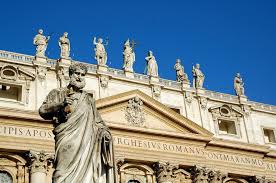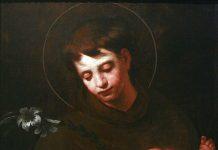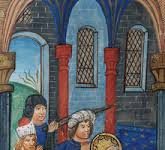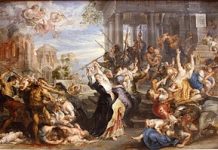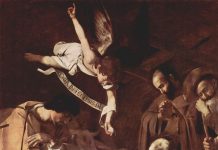We celebrate today, Pope John Saint I (+526). One might wonder why it took five centuries for a Pope to be chosen with this very biblical and apostolic name. But, then again, up until the time of Pope John, Popes kept their baptismal names, and it was not until 533, when a certain Mercurius was elected, who thought his pagan name unfitting for the head of the Catholic Church, took the name of his predecessor, John II.
It is also curious that the names of the Evangelists, nor even the Apostles have never been popular with Popes. There has never been a Pope Matthew, Luke nor even Andrew; there was one Pope Mark who reigned less than a year, and, of course, the original Pope Peter. The prophecies of the 11th century Irish monk Malachy, likely-largely-apocryphal, declare that the next Pope to choose the name ‘Peter’ – Peter II? – will be the last Pope at the end of the world. But this may be figurative; or the prophecy more likely spurious. One must keep one’s wits about one.
Pope John, who was already elderly and frail when elected, was nevertheless sent by the King Theodoric to Emperor Justin at Constantinople, to seek better treatment for the Arians, who held a heresy that claimed Christ was not really, fully God, to which Theodoric, along with most of his barbarian compatriots, heartily subscribed. It was, I suppose, easier to grasp that Christ was a created being – not God – than the complexity of the dual natures of Christ, united in one hypostasis. Much more simple to make Him (or, for them, him) a more pliable creature, to whom they need not fully submit. After all, only God has full authority, and if Christ is not God, well then, what power has Christ, really? Or, for that matter, His vicar, the Pope? Arianism, the denial of Christ’s divinity, gave emperors total totalitarian authority, which sounds sort of familiar.
Pope John made the arduous 1300-mile journey to Constantinople, far more difficult in those days than ours, over dry dusty roads, mountains, vales and stormy seas – with a large and venerable retinue. Emperor Justin received the Pope warmly, and the delegation from the West got more or less what Theodoric wanted. Well, almost, for Justin did not grant the concession that those clerics who converted from Arianism to Catholicism would be ‘restored’, that is, keep their hierarchical positions. The emperor claimed that their former heresy precluded them, as possibly forming an undermining ‘fifth column’ in the Church.
So upon the Pope’s return, Theodoric accused him of conspiring with the emperor, and in a fury had him thrown into a dank prison in the capital of Ravenna, where he, already old and frail, died on this day in 526 of neglect and ill-treatment, hailed as a martyr for the truth.
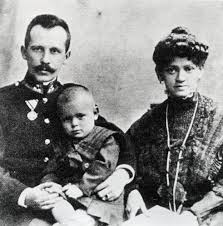
(pinterest.co.uk)
We also celebrate today what would have been Pope Saint John Paul II’s birthday. JP II had 84 of them. Benedict, the XVI made it to 95. But the last decade or so of those years he held the controversial title of Pope Emeritus – the first Pope ever to do so. But, then there have only been five or so that have retired from the Chair. The oldest actual reigning Pontiff was Leo XIII, who held the Chair until he went to see Saint Peter at the venerable age of 93, making him the oldest Pope in history. I am sure John Paul is celebrating his birthday in fine style in heaven, even if in Poland, and other European cultures, they do not celebrate their birthdays so much as the days of their patron saints, which for Karol Wojtyla was November 4th, has namesake, Saint Charles Borromeo.
But I am sure that both Charles the Cardinal and John the Pope were in some ways guiding the life of the young Karol, knowing he was destined to take on the mantle of the papacy, and travel, pray and suffer, more than his eponymous predecessor, for the Church universal. John Paul II’s would-be assassin was from Turkey, where is found Constantinople, now named Istanbul.
It is only in the breadth of eternity that we can truly discern the events not only of this world, but in each of our individual lives. What in the rather limited scale of secularity appears as ‘failure’ may in fact be our greatest success, which is why we honour martyrs such as Pope John. Like John Paul II 1500 years after him, his ending seems tragic, but their equanimity in persecution, misunderstanding, even apparent futility, sickness and death, is their greatest triumph.
We all must witness to that same truth in our own way, as God so wills.
I had a dream once that I was climbing – or more like hiking – a mountain with the Pope who shares my name (and I had it first, I might add). Perhaps someday, in the new heavens and earth, that dream may come true, when we’re all at the perfect, vigorous age, if there is such a thing as ‘age’ in heaven. After all, there must be mountains galore to explore in that new heaven and earth to which we all look forward.
Be not afraid, for I am with you…to the end.

